Camera Eye
Eye Evolution
What is Life?
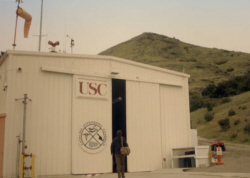
USC Cabin
I can show you by building an eye.
The first step in building an eye would need to take some kind of light-sensitive pigment, rhodopsin, for example, and build it on to a membrane. So,
imagine this is such a membrane, with the pigment cells attached, then immediately you have something that can detect the difference between dark and light.
Now, the advantage of this arrangement is that it's very sensitive to light.
There is no paraphernalia in front of the retina to block light, but the disadvantage, as you can see, is that there is no image formed at all.
It just allows you to tell the difference between light and dark.
But you can improve that a lot by adding an aperture, a small hole in front of the retina, so this is a movable aperture, just like the sort
of thing you've got in your camera, and now, we see that the image gets sharper.
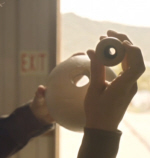
Simple Aperture
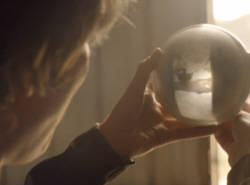
Sharp Image
But the problem is that in order to make it sharper, we have to narrow down the aperture, and that means that you get less and less light, this
eye becomes less and less sensitive. So there's one more improvement that nature made, which is to replace the pinhole, the simple aperture… with a
lens. Look at that. A beautifully sharp image.
The lens is the crowning glory of the evolution of the eye. By bending light onto the retina, it allows the aperture to be opened, letting
more light into the eye, and a bright, detailed image is formed.
Our eyes are called camera eyes, because, like a camera, they consist of a single lens that bends the light onto the photoreceptor to create a
high-quality image of the world. But that has a potential drawback, because to make sense of all that information, we need to be able to process it.
Each one of my eyes contains over 100 million individual photoreceptor cells. And that's about five or ten times the number in the average
digital camera. So if my visual system works by just taking a series of individual still images of the world and transmitting all that information
to my brain, then my brain would be overwhelmed. It's just not practical, so that's NOT what animals do. Instead, their visual systems have evolved
to extract only the information that is necessary.
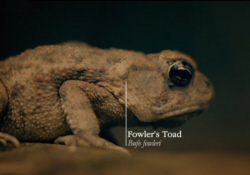
Fowler's Toad
Fowler's Toad – Bufo fowleri
And this is wonderfully illustrated in the toad . the toad has eyes that are structurally very similar to ours. But much of the time, it's as
if it isn't seeing anything at all. It seems completely oblivious to its surroundings. Until something, like a mealworm, takes its interest.
If you think about what's important to a toad visually, then it's the approach of either prey or predators, so the toad's visual system is optimised
to detect them. So, there, we've put a worm in front of the toad, and did you see that? Incredibly quickly, the toad ate the worm. As soon as the
mealworm wriggles in front of the toad, its eyes lock onto the target. Then it strikes in a fraction of a second. It's an astonishingly precise
reaction, but it's also a very simple one.
Because the toad's only focusing on one property of the mealworm – the way it moves.
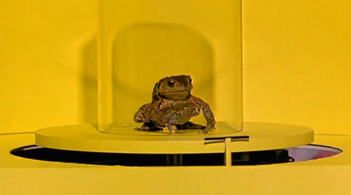
Laboratory Toad Test
These 1970s lab tests show how a toad will try and eat anything long and thin but only if it moves on its side like a worm. And that's because
the toad has neural circuits in its retina that only respond to lengthwise motion. If, instead, the target is rotated into an upright position,
the toad doesn't respond at all.
At first sight, the visual system of the toad seems a little bit primitive and imperfect. It is true that if you put a toad in a tank full of
dead worms, it'll starve to death, because they're not moving, so it doesn't recognise them as food. But it doesn't need to see the world in all
the detail that I see it. What it needs to focus on is movement, because if it can see movement then it can survive, because it can avoid predators,
and it can eat its prey. I suppose, in a sense, if it moves like a worm, in nature, then it's likely to be a worm.
This ability to simplify the visual world into the most relevant bits of information is something that every animal does. We do it all the
time. We also have visual systems that detect motion. Others identify edges and faces. But extracting more information takes more processing power.
That requires a bigger brain. And to see the results of this evolutionary drive towards greater processing power, I've come to the heart of
metropolitan Florida.




